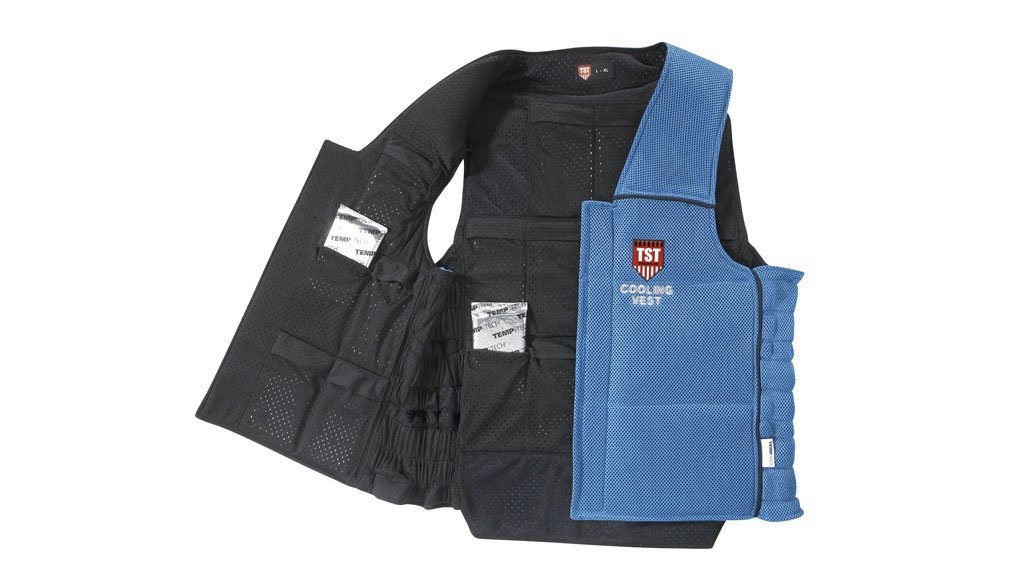Cooling vest reduces industrial heat stress


JUST CHILL TST Sweden’s cooling vest consists of nontoxic, nonflammable compound blends of salts, which are known to be an effective ingredient for temperature regulation
Staff exposed to hot environments, in combination with doing arduous work and wearing multilayered protective clothing, such as firefighters, may suffer thermal physiological strain, says water jet cutting company Total Blasting, which is the South African distributing agent for Sweden-based protection equipment manufacturer TST Sweden’s cooling vest.
Such strain, which is exacerbated by heat dissipation and evaporation being restricted, can result in reduced working performance and increased risk of heat illness. One of the measures that can reduce such adverse effects, thereby increasing work performance, is to use personal cooling equipment to improve the microclimate around the human body.
Total Blasting – part of industrial supplier and solutions provider Total Product Solutions Group – now offers TST’s cooling vest, which is suitable for hot environments, such as concealed tanks or vessels, where heat stress is a common occurrence.
Total Blasting sales director Bradley Storer tells Engineering News that the cooling vest enables workers in conditions where the body is under stress from overheating to maintain a comfortable body temperature, significantly reducing the risk of fainting or dehydration.
“When your body is regulating temperature, you sweat, and with body fluids emptying, it can lead to a 3% loss of weight in fluids, which subsequently leads to a loss in work performance of between 20% and 30%.”
Storer notes that examples of industries that would benefit from using this cooling vest, such as fire and rescue services, cast-iron working, nuclear, mining, oil and gas, chemicals, steel, paper mills, refineries, military, police, diving and sports such as horse riding or motor racing.
Total Blasting supplied a cooling vest for industrial cleaning company Wasteman in January, after a worker fainted from heat exhaustion inside a reactor.
Temperature Technology
The cooling vest consists of Temptech elements, which are nontoxic, nonflammable compound blends of salts, which are known to be an effective ingredient for temperature regulation, sealed inside an aluminium wrapper, explains TST regional sales manager Annette Hessel.
The vest is made from polypropylene fabric, which has a powerful moisture management transfer level up to 40 times more than that of standard polyester.
Hessel points out that the Temptech elements, which are natural elements that have a 20 ºC transition temperature, enable the vest to store energy and absorb excessive heat for 90 min in a 60 ºC environment, such as in smoke diving for firefighters. Also, in 45 ºC environments, such as inside a tank, vessel or in a mine, the vest stores and absorbs excessive heat for 4 h.
Thereafter, the vest needs to be recharged for 4 h at room temperature, or, ideally, if the recharging environment is below 20 ºC, it needs to be recharged for between 2 h and 3 h. In an 8 ºC environment, the vest needs to recharge for 30 min.
Hessel notes that TST guarantees 1 000 use cycles for the cooling vest, if properly maintained.
For best results, Total Blasting recommends that the cooling vest is used tight to the body, with a light cotton garment underneath and a garment over the vest to ensure optimal heat absorption.
The company also suggests not storing it in a warm place, as it will absorb heat and not recharge properly. If a client needs the vest to perform continuously, Total Blasting offers TST’s Temptech replacement kit, which contains replacement cooling packs.
The TST cooling vest range includes an Ultra version, which is optimally designed for individual use; the Multi and Flexi versions, which are optimally designed for multiple users, with less adjustment options than the Ultra version to suit one person; and the Flame-retardant and Nomex versions, which are designed to handle demanding open-fire conditions.
Article Enquiry
Email Article
Save Article
Feedback
To advertise email advertising@creamermedia.co.za or click here
Comments
Announcements
What's On
Subscribe to improve your user experience...
Option 1 (equivalent of R125 a month):
Receive a weekly copy of Creamer Media's Engineering News & Mining Weekly magazine
(print copy for those in South Africa and e-magazine for those outside of South Africa)
Receive daily email newsletters
Access to full search results
Access archive of magazine back copies
Access to Projects in Progress
Access to ONE Research Report of your choice in PDF format
Option 2 (equivalent of R375 a month):
All benefits from Option 1
PLUS
Access to Creamer Media's Research Channel Africa for ALL Research Reports, in PDF format, on various industrial and mining sectors
including Electricity; Water; Energy Transition; Hydrogen; Roads, Rail and Ports; Coal; Gold; Platinum; Battery Metals; etc.
Already a subscriber?
Forgotten your password?
Receive weekly copy of Creamer Media's Engineering News & Mining Weekly magazine (print copy for those in South Africa and e-magazine for those outside of South Africa)
➕
Recieve daily email newsletters
➕
Access to full search results
➕
Access archive of magazine back copies
➕
Access to Projects in Progress
➕
Access to ONE Research Report of your choice in PDF format
RESEARCH CHANNEL AFRICA
R4500 (equivalent of R375 a month)
SUBSCRIBEAll benefits from Option 1
➕
Access to Creamer Media's Research Channel Africa for ALL Research Reports on various industrial and mining sectors, in PDF format, including on:
Electricity
➕
Water
➕
Energy Transition
➕
Hydrogen
➕
Roads, Rail and Ports
➕
Coal
➕
Gold
➕
Platinum
➕
Battery Metals
➕
etc.
Receive all benefits from Option 1 or Option 2 delivered to numerous people at your company
➕
Multiple User names and Passwords for simultaneous log-ins
➕
Intranet integration access to all in your organisation















